Thirty years ago, Armand Leone was a regular visitor to Australia where he married Aussie team member, the late Susanne Bond. Watching Armand ride was fascinating, interviewing him AMAZING! He was simply the most articulate jumping rider I had ever met. Nowadays, Armand also has a law degree and runs a equine law firm, check out the website, there’s great information to be had on equestriancounsel.com
Now back to 1986, and I’m at horse show, watching Armand warm up Secret Keel for Susanne…
The horse is the big Warmblood gelding and the warm up is smooth and impressive. Quietly getting the horse on the bit, asking him to bend, to come under and carry himself. It is the first time the young American has ridden the horse, but he is no novice to the game of fine tuning jumping horses.
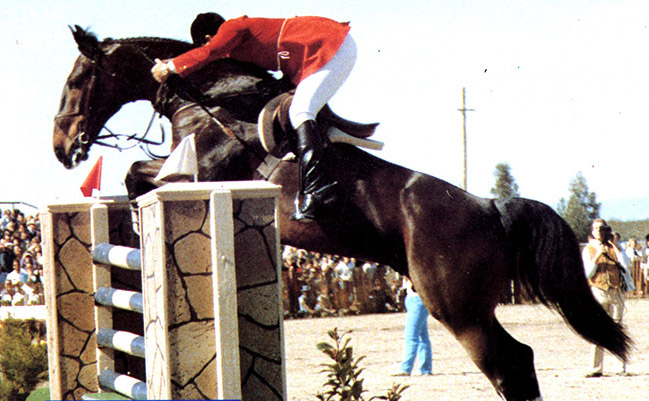
Eleventh in the World Cup on Jonker…
In 1986, Armand competed at Berlin, to finish eleventh in the World Cup.
The warm-up is unhurried, but is gradually getting more demanding, the canter circles are getting tighter, the horse being asked to flex to the inside and the out. The rider is winding the gelding in, that tight circle becomes a half pirouette, out on a straight line, pirouette, again and again, asking and getting the response. The instrument is handed to the owner, the tuning-up is complete.
Time for the promised interview. I learnt a while ago that American showjumping riders were not only master technicians in the saddle, on the ground they talk with – if this is possible – even more flair. One attempt to follow the flow of words from the doyen of American riders, William Steinkraus, with a note pad and pen had already prompted the purchase of the little tape recorder. It’s primed and ready to go, but still I barely get time to hit the record button, before the torrent of words, concepts and images begins. As he touches down in the chair, Armand is off and firing – the interview is underway …
“The reason I was doing those pirouettes and stuff is that I had the good fortune to be trained by George Morris. He is our trainer, but with me working, and him away showing, and my showing, I don’t really get a chance to work out with him so often. Maybe four or five times a year now.”
“When I was seventeen I rode with George Morris all the time. Mostly hunters and equitation. I love George and respect him. He has a system and a methodology that is incredible. His genius is to be able to see a horse and a rider and their problem. And not only to be able to say, yes they have a problem, but to be able to fix it.”
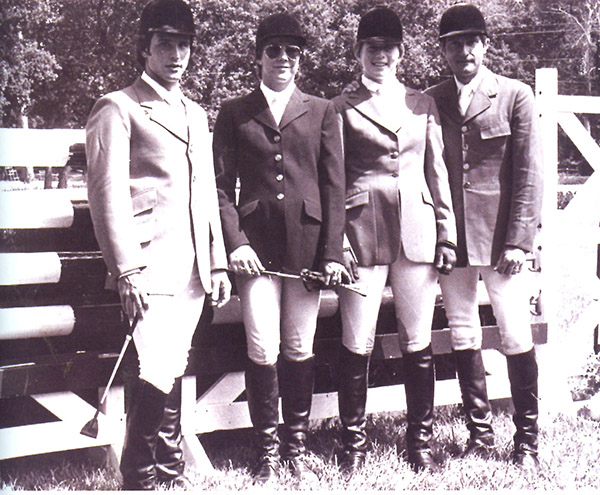
Touring Europe with George’s team: Armand, Betsie Bolger, Debbie Malloy and George
“He made me work on pirouettes, that was the new exercise for my Grand Prix horse. The new exercise was figure of eight, small voltes with the haunches in. I do a lot of dressage work. First of all you can’t jump these Grand Prix horses. Once they know how to jump, they jump at the horse show and maybe one school before. You can’t jump their legs off – they become too precious.”
“George taught me to do this figure eight with the haunches in, and through the transition, the canter change. Figure yourself, you arc in a small volte now, haunches to the right, now you come onto the figure eight line, and as you do your change of lead, haunches in to the new circle. The haunches really come across first and everything else is coming with the outside leg and the outside hand. He changes behind first, and as the haunches are moving across.”
“Specifically with that horse I was using the pirouette to solve a problem. Susanne has two nice horses, but no horse is perfect. All horses get rusty, they have the intelligence of two-year-old children. They have a good memory for things they don’t like, but they have a short attention span. I watched her ride yesterday, and it seemed to me that she had to work too hard on the turns in the jumpoffs. She was pulling them around in the turn.”
“So if I can help today to sharpen, to make that horse more crisp to the outside leg, that may help her tomorrow. I want him to turn straight with impulsion. Now that horse is not a cutter. You can get the cutting problem when they throw the shoulder in. They get quick, they cut in, and they’ll have a fence down because they are on their front end.”
more follows
“So that is what I was doing. If I was riding this horse for six months, or a year, I could plan out a program over that time. I am basically involved with this horse for two days, you have a pick a little battle you can win, a little project that you can complete. You can’t build a bridge in a week, but you can throw a board across a creek.”
“So today was a practical lesson to get that horse turning from the outside leg, with the idea of the short term result – the horse shows on Sunday.”
“With my own horses I have a repertoire – and this probably sounds like a bag of tricks – of various exercises. I have a basic system, the Hunt Seat system as taught by George Morris. He is my prime teacher of equitation. Bertlan de Nemethy is probably my next best coach. I worked with him for two years and did a European tour with him. He had different exercises and different things. They would take the same balance and describe it a little differently, but each one has specific exercises and patterns. Maybe serpentines, figures of eight, shoulder in, two track, half turn and reverse, volte.”
“One talks about make a little bending and straighten, the other will talk about apply the leg, contact with the mouth and release them both. George talks about leg to hand exercises, Bert talks about bending exercises.”
“So one maybe stresses latitudinal work, one maybe stresses longitudinal work. On a given day with my Grand Prix horse -who basically can do everything in my Dressage manual so to speak – we will do just a few of those exercises, you can’t do it all. Given that everything is alright, he is not having a particular problem in a specific area, you orchestrate a certain series of exercises. Like an aerobic’s teacher would do. He is an athlete, by working his hind end, by making him do all sorts of flexions and bendings, collections and extensions, I can exercise his back, his legs, his neck, as much as jumping, and I can make that horse sweat.”
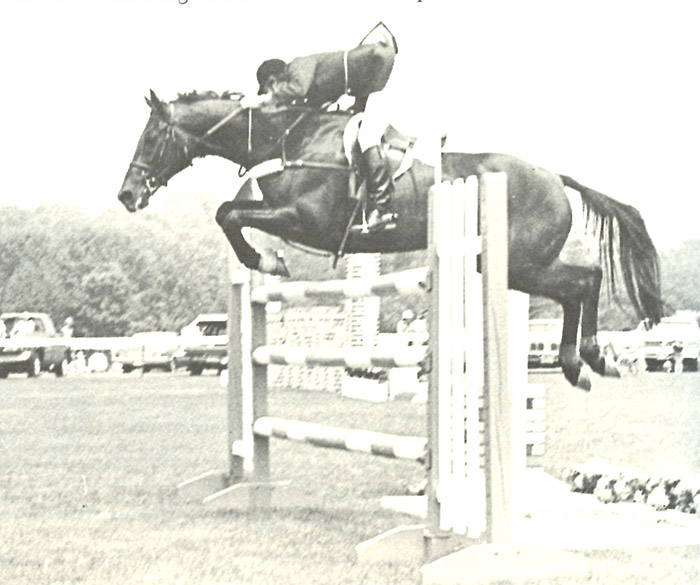
Armand and Sombre, from George Morris’ book, Hunter Seat Equitation – George comments: A terrifically competitive pair when going for time. Don’t worry if a few things slip when riding fast; they will. Armand is shown making a sharp right turn in the air. And meaning it!
“I can really make him work, and not get out of the trot – and not be brutal. Oh no! If you just make them do what they didn’t want to do. You don’t practice what they are good at, you practice what they are not so good at – then you reward them by doing a little bit of what they like. You can’t beat them into the ground mentally – you have to take care of the spirit of the horse.”
“I have a collection of exercises, then jumping gymnastic exercises, no stride bounces, eighteen foot gymnastic in and outs, and quadruples and pole, vertical, pole. In any one year you might do each one of these exercises once. Maybe at the beginning of the circuit, with my Grand Prix horse, I’ll take two schools and maybe do an eighteen feet in and out with a canter pole coming in nine feet in front.”
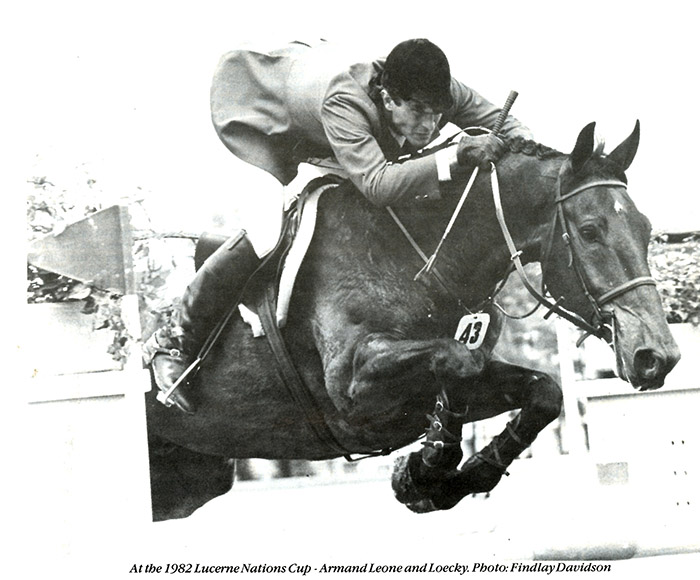
“By that time you are starting to show, and you are jumping at the Grand Prix on Sunday, now your schools become more specific. Maybe you are jumping more horse show oriented courses, course simulation. Over the years from George Morris, Bertlan de Nemethy, Frank Chapot, Billy Steinkraus a little bit, Sullivan Davis, Hans Winkler, Malcolm Pyrrah, those seven people have given me various exercises.”
“When you are riding around and everything is perfect, no point in doing that any more – try another exercise. If he does that perfect, fine – go on and try something else. When you find something he is not too good on, well work on it a little bit, you’ve found a project.” ‘My preparation for horses is really a collection of things you pick up from the genius’s all over the world.’
“You always have a weak spot, it’s like a sea wall. It’s like putting a wall up against an ocean. You build it and carefully lay all the foundations and you teach them all the things, but as time goes on, certain areas get weak. You don’t pay enough attention to that area for a while and it starts to erode. They are not so responsive say to the outside leg, and you go to a horse show one day and you have a problem in the course because he didn’t respond. You went to turn around and he bulges out and you get to the oxer a foot further out than you wanted and unfortunately it was six and a half feet wide, and you lost the Grand Prix. Next day you start working on the outside – well it’s too late.”
more follows
“You keep continually checking with your good horses. Young horses don’t know too many tricks. A young horse maybe only knows four things. So you go out with your young horse and do your four things and if he does that well, you start teaching him a fifth. Then you mix back in to one of the other four and back to the fifth. And when he understands five, you start with another.”
“You keep playing them, you may get up to twenty, thirty, forty different patterns or exercises you can do. My preparation for horses is really a collection of things you pick up from the genius’s all over the world.”
Are you ever worried that with all those concentrated dressage exercises that you will rob the horse of his fire – his initiative?
“Am I worried about losing the killer instinct? No, not one bit. We are talking of doing this at home, or we are talking in the morning. We’re very different to you Australians – you guys are like the Californians. You guys want to jump big jumps, come to the horse show, get on the horse and jump. I like to get up early and work. Let’s say I have a competition at two in the afternoon, or eleven in the morning. I take the horse out at about around seven thirty in the morning. Do thirty, forty minutes flat work, not jumping. Work on his head.”
“People talk about a horse’s jumping head. Unfortunately with the dimensions and the lightness of the rails on today’s courses, and the related distances, horses have to be thinking. They cannot be fighting the rider when he is trying to ride the course. You can get away with it on single jumps – but you can’t get away with it at the Olympic Games. You can’t get away with it at the World Cup. Fifteen years ago you could keep them wild, and spirity, and fiery, you need more control than that today.”
“I’ll work thirty, forty even fifty minutes in the morning. Not to jump. Then he comes out for the class and I get on ten minutes before and we set up basic exercises. Not picking any fights. If I’m going to fight, or pick an issue, I’ll pick it in the morning. Let’s say I want to get him to the outside leg, if I’m going to work on that, I’ll work on it in the morning. But at the horse show for the warm up you don’t pick any fights.”
more follows
“When you go in the ring, you don’t think about shoulder in and all that -you ride the course, that all becomes instinct. You forget it, it becomes reflex and instinct. You practice these things so the horse doesn’t think about it, he doesn’t understand why. You ask for the bendy bends, you ask for the cutty cuts. If you kept doing it, he would start doing it all the time, any way. But no, in the morning you go out and do different things.”
“Basically you try to do all the communication work and the intricate work in the dressage, so that in the ring, in the excitement, and when their blood is going, when everything is four sheets to the wind, all those hours you put in are there … if they are there, OK, they just happen.”
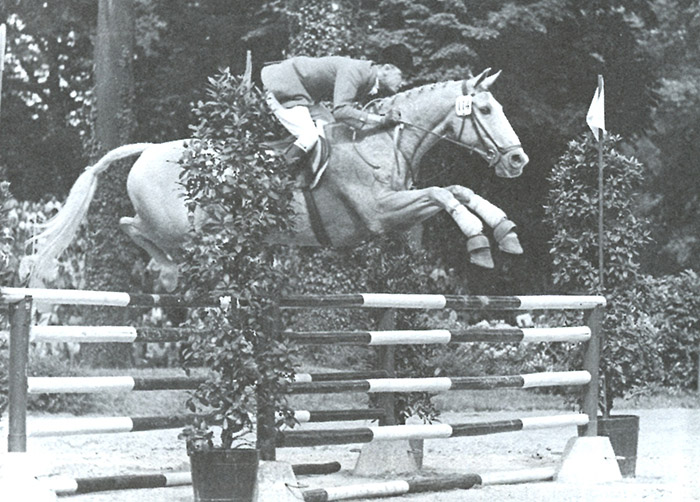
Nautilus – the one you couldn’t flat – with Hugh Wiley
“I will concede that there are one or two horses in the world at any particular moment, that cannot be ridden with understanding. One was Nautilus, the palomino horse, and I believe this because Bert de Nemethy told me that you could not school the horse. At a horse show the rider would just get on and do one vertical and go into the ring. That’s the way the horse rode. At home the groom would ride him, but you could not train him. Bert could not train the horse.”
“Because of that story, yes I do believe that there are some horses that you just can’t train, that are freaks. More times than not they are just horses that are difficult, and people do not have the depth of understanding – because it takes years, and unfortunately these days, money. If you have the time, and the money to get to work with people like Frank Chapot, or George, then you can deal with the difficult animals. I had a horse that I thought you couldn’t ride on the flat. I went to Bert de Nemethy and I rode with Bert for three weeks and at the end of the three weeks he was doing it all. He was round and bending, doing his two track work. .. and yes, Bert, you are right! He is not bucking and kicking and racing, he is nice and round and you can read a book while you ride him.”
“Some horses are very easy to ride classically, and anyone can do it. But you get a hot horse that doesn’t like leg – the answer is not – to not use leg. The answer is to use a constant gentle leg. But you have to know that you are doing right. You have to believe in your soul that you are doing right, because he is not going to like it at first. At the walk – the leg stays there. It doesn’t get more, it doesn’t get vindictive, it doesn’t get punishing. It just lives there. It may take a week, it may take a month, it may take just half an hour – but eventually, just like any constant thing, all of a sudden you stop noticing it.”
“It’s typically the hot horses that people say can’t be ridden. Yes it’s more difficult, but once you get it, they are the best, because they don’t run out of gas. At the horse show you think left, and they’ve gone left. You don’t have to do the sort of work I was doing with the Warmblood horse today on a hot Thoroughbred. If I had been working one of the Australian bred horses, I’d have been working on inside bending, soften him to the inside, because they cut.”
How did you first get to train with the jumping genius of the twentieth century – George Morris?
“We went and asked. I’d been riding for eight, ten years on the equitation scene, he’d seen us. We were intimidated by him, we thought ‘he won’t want to know us’. Finally my father went and asked him and he said ‘I’d be delighted, I’ve always wanted to work with them’. So I went with George on his first trip to Europe. I rode two horses and I won three Grand Prix! We had a fabulous circuit. I was eighteen, nineteen that trip. George has never forgotten that.”
“I’m a great student, like I’m a doctor. My parents would never allow me to make horses my business. I was the oldest son, and they are doctors, I was going to school. But the deal was if I went to school and was good, they would get me a horse. When we started riding with George, I had always been a good student. One, because I always wanted to cut out early so I could go ride my horses. I’d miss a week because I went to Florida for the horse show, so I had to be extra good at school because I didn’t want to be there.”
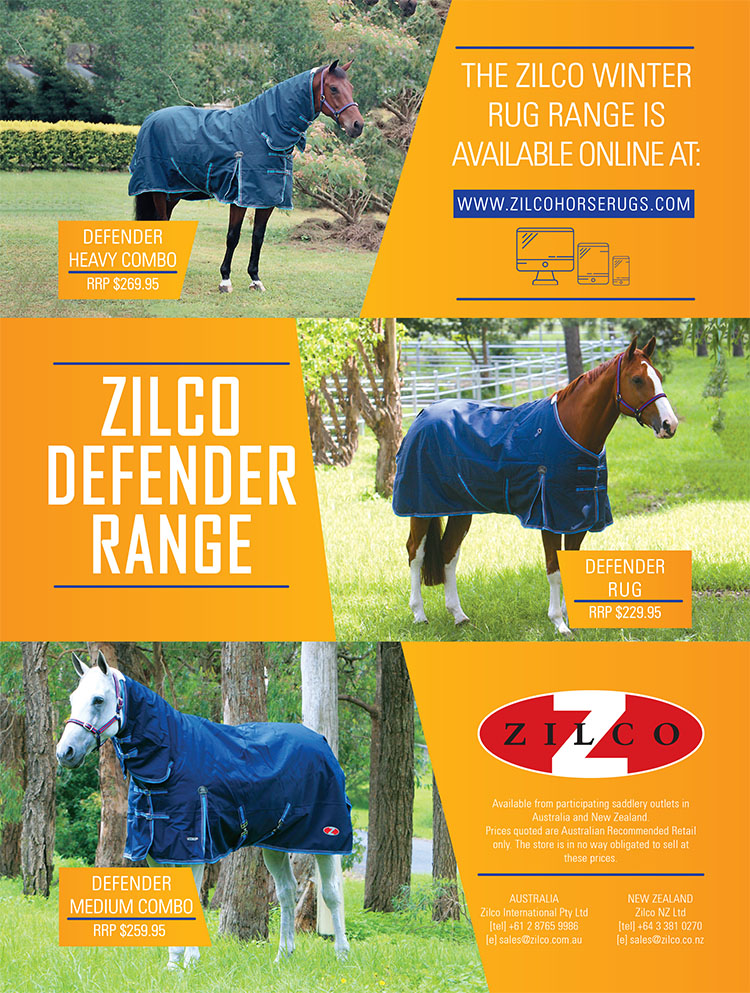
For more information: https://goo.gl/dA11Wf
“What you do is soak up what you can. I rode with George and Bert and they were the same. I remember riding with George at seven o’clock in the morning, in the vineyards in Bordeaux, and he is talking about the classical and the French leg aids, about Jessica Newberry, about dressage. It’s kind of a blast, you never know what you are going to discuss in a lesson. I remember him that morning saying that riding is like high school, college and doctorate training.”
”You start with the ponies and you are in grade school. You go along and you get to the hunters and equitation and you are in high school. You get to the jumpers and you are maybe thirty, forty years old, you are in college. Past that, you get to fifty, sixty and become a master and you become a dressage artist. Dressage is like the post graduate training.”
“Of course I was trying to have a bit of a good time in Europe. You have a bit of a late night and you are sitting there in the vineyards, and even though it was true and I loved it, but I started cracking up… I didn’t laugh out loud of course… but it’s great, he keeps you into the art. He keeps you in tune with that part of it. And if you can enjoy that part of it, you’ll never get tired of it.”
You are naturally the sort of rider who enjoys that sort of intellectual approach of thinking through problems?
“I am. I’m not as bad as my brother. I like to do it, but just like with an old horse, if you do anything too much it is bad. When you go into the ring, you’ve got to be able to stop. When you are getting ready for the horse show, you have got to be able to deal with practical things. If you have to give him gymnastics, or school for water, or lay a stick on him. All the bending and everything is nice, but you have to deal with the problem first.”
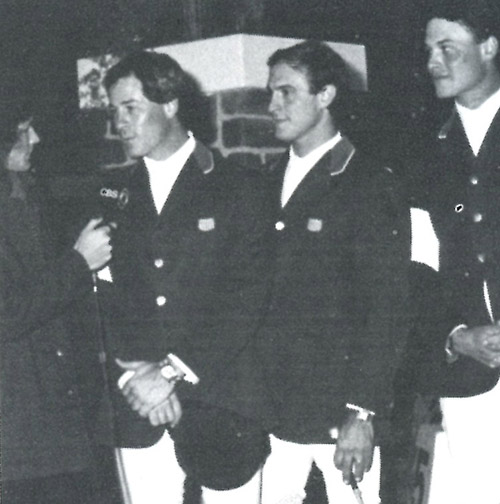
The Leone brothers – Peter, Armand and Mark
“I am not as overly intellectual as my brother Peter, but I am more intellectual than my brother Mark. Mark has a little more natural talent. He’ll have the groom ride the horse in the morning, maybe trot the horse, then go in the ring. Peter will ride on the flat for an hour and a half and just do trot pole cavaletti, and if he gets a little rub in the schooling area, that’s enough. I’m somewheres in the middle.”
“Susanne is good for me. She gets me to tone down a bit. You get to the point when you are doing post mortems – it’s too much. You have your round, discuss what you thought, look at the video once. Then there is a time when you have got to quit all that analysing.”
“I think video is too forgiving. Great rounds only look good, and horrible mistakes don’t look so bad. I think video is good for counting strides, or seeing where you turned, or remembering a course when you are preparing. As an analysis of riding, for some people it is very good, for me it is difficult.”
At the moment what horses are you campaigning?
“All purses have a bottom, with the prices of horses today. My brothers are younger than me so they have two or three good horses. I have one right now, Jonker. A Dutch bred horse, a good horse, not a great horse. He is not a Calypso, or a Touch of Class. He’ll jump any course. We jumped in Berlin and he was eleventh overall for the World Cup.”
You didn’t try for LA?
“We have too many professionals. They call themselves professional amateurs but we have too many professionals. Any way, I was busy with my Radiology Specialist training. I’ve been a doctor for four years, I finish my radiology specialty training in June. I couldn’t stop going to school and I love the riding too much to give it up. I thought I was going to have to give up riding, but I didn’t. I love horses and I like medicine as work. Maybe the balance will swing from month to month or year to year. For the next six months, finishing my residency is the most important thing.”
“For the latter half of 86, I want Susanne to have two or three nice horses, and me to have a pair, and we are going to ride with George Morris in Europe. Hopefully George will come. We’ll ride in Europe for three or four months, together. If we don’t want to ride for two or three months, and Susanne wants to go to Africa for a Safari, which is something I’ve always wanted to do, we’ll do that.”
“I’ve got tons of years to ride, and I’ve got news for you – this game doesn’t change. The game is the same on this continent as it is on any continent. I stopped riding competitively for a year, and I came back and I am riding better than ever. The physical end you get back in a couple of weeks or a month. Then it is getting your mental game back, and that’s experience. So our idea is to ride a bit at the end of the year, but if we change our mind – that’s OK”
You don‘t want to ride at the Olympics?
“I don’t really care. For the United States it is impossible, basically because we have too many professionals. I can’t afford to spend two or three million dollars to buy two or three horses to have a thirty percent shot at making the team, and then have to go to six Olympic selection events, risk injury or breakdown, and then get to the Games and not know until two days before if you are going to be the four out of the five who gets to ride.”
You wouldn‘t consider trying to make an Olympic horse yourself?
“Let’s put it this way. If you told me that you want me to go out and go to the World Championships next June, my friend you can’t go out and find a greenie and get it ready and do it. If we are talking ’92 Olympics we have to talk percentage. You give me one hundred well-bred horses. Give me enough people to break them and train them as yearlings and two-year-olds and three-year-olds. We trim down to fifty at three. At four we get down to twenty five and we campaign them all for a year. Then we get down to a group of six, and these six we say are the best. Then we take them up to the Grand Prix and we are already talking four years, six years down the road. Out of that we find the one that is a world class horse. We can do it that way – but do you want to bet the farm on it?”
“We’ve made some. We have two we bred ourselves. We have two expensive horses. We usually take problem horses. Not bad horses, but the horse that maybe has a little stop, or a little problem. Over the past four years, we have had maybe twelve Grand Prix horses, I’d say six were horses that were difficult, either they were too hot, or they would stop or they were difficult to ride. We bought them for a modest price. What’s a modest price? $60,000. We had some cheapies. We had some we bred ourselves, one happened to be my equitation mare’s foal, and I think it will be a nice horse. But it’s not going to be a free horse, really. What’s it cost – four thousand a year to keep a horse? He’s already five years old, so that’s twenty thousand dollars already.”
“We have two horses that we bought for my brother because he was trying to make a bid for the 1984 Olympics, and yes it was his turn, and yes we spent two hundred thousand, something like that. Too much money as far as I am concerned. But in all seriousness, he wanted to go and try for the Olympics. You can’t go in a Grand Prix car race with a Volkswagen. Especially when all the other guys are professional drivers and you might not be so professional.”
“I’ve learned on lesser quality horses, and the mistakes are the same – it’s just that the vehicle you damage isn’t priceless! I think it is better to wait and plan to make that special purchase at the time it is right. The time when you are ready for it. When you have decided this is what you want to do and are prepared to put six months into building for that. For me now I have one good Grand Prix horse and I can compete anywheres in the world. I might not win every day. Maybe four faults in jump off, but he’ll be tenth, fourth, fifth – win a thousand, four thousand, three thousand. I’m in the groove. He is safe to ride. He is classical. When the time comes… you change the vehicle underneath me.”
“I enjoy just what I was doing today, just schooling a horse. Sure, I’d like to win the King George V Cup, I want to win the Bond Derby one of these years, I want to win Aachen Grand Prix, someday I will – maybe not all of them. I’ve learnt that there is no rush. It is not going to change. Horses have been like that for hundreds and thousands of years. They are not going to change. We are all worried that they are going to change, but they are not.”
“They are going to get more expensive, but that’s about it. They can’t make the jumps any bigger. They can’t make the poles any lighter. They might get smarter. In the States they might go down to one horse per rider, and it will become easier.”
“Something like the Olympic Games you plan for. Set a goal and go about it. When we are talking Olympic Games we are talking about a plan for a rider over a period of four years. We may be talking about three horses and a proper progression for that one rider. When is the right time to purchase horses to win the selection events? When do you want to purchase the horse for the Games? The ideal way is to have a horse that you become selected on, and have another horse that you are going to use in the Games.”
“The most brilliant horse I have ever ridden was the mare I took to Europe with George – Encore. She was a very difficult Thoroughbred mare, only 15.3hh, but very hot and incredibly fast and cluey. She was a terror, but a winner. I loved her for that.”
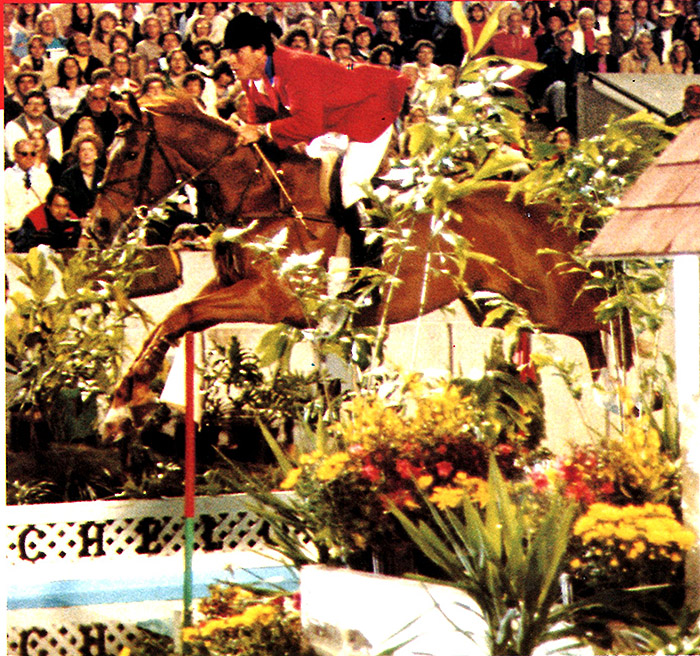
The most brilliant – Encore
“The horse I am riding now is the most classical horse I have ridden but the other one just knew when it was a big day – this one either doesn’t know, or he doesn’t care sometimes. I’ve never had what I would call a world beater.”
“My brother has two that are really nice. I think I may at the end of next year, with my family, try to purchase a horse for myself, because if you want to get sponsors involved, and you want it to get world class, you have to have world class performances. You can’t just do it in the backyard. You’ve got to be able to go and compete anywhere in the world.”
What have been your best performances?
“Just to hit a quick run down, the first year I went to Madison Square Garden I was leading National Rider in ’77. I won two classes, I’d never won a class before in the open jumpers. 1978 I went to Europe and won three Grand Prix. In 1980, I went to the Alternative Olympics, won the Puissance at Wembley, won double clear rounds in the Aga Khan Trophy.”
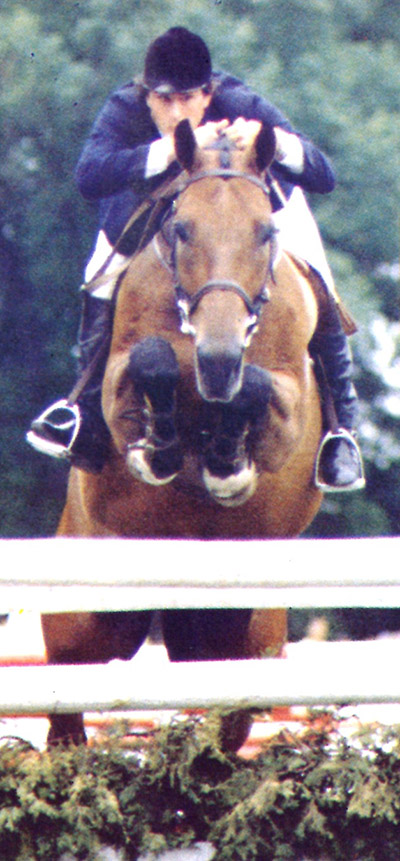
Winning the Aga Khan on Wallenstein
“That was special, I had to go first for my country. The training of George Morris made all the difference in the world. When I got over the last fence the timer was ten metres away, and I heard the echo of George in my head ‘Gallop!’ When I landed I put my spurs in and made him gallop. I knew we jumped clear and you want to pat him, no I made him gallop to the timers, and I was under in one hundredth of a second! One hundredth of a second and we would have had a quarter time fault, and we’d have lost.”
“Next time I came out I knew how tight the course was so I made it up in other places. But if that hadn’t been drilled into me as a junior, as an amateur jumper with George standing at the end gate, shouting “Turn, gallop”, if that hadn’t been instinct, we’d have lost a Nation’s Cup!”
“We always have this thing in the United States about selections for the World Championships, that they should be points. Whoever wins the most points should be selected. George said, they always say that, but it’s never going to be that way. Because it doesn’t matter just jumping big jumps. It doesn’t matter if you can go out and jump back and forth all day over a six feet vertical, or if you happen to be good in your backyard.”
”You need to have the foundation and the training that when there are eighty thousand people in the stands around you, and it has been raining all week, and you are going to jump the biggest course in your life … don’t come to me telling me it’s too muddy, or you don’t like the schooling area, or it’s too deep, or you don’t know how your horse is going to jump. You better have the foundation, and the fortitude, and the belief in the system that you can handle it”
“And that’s what I feel I have got. I can go anywheres in the world and I don’t care where it is and what it is, I can cope. But you can’t take a team of four riders with ftve horses to the Olympic Games or the World Championships and have someone not being able to cope. Experience is important. Yes, current performance is important but it’s not the only thing.”
“For me that double clear in the Aga Khan was a fantastic moment. I’ll never forget that. But if I hadn’t had that training it wouldn’t have been a brilliant moment… One of the other guys on the team did have a half time fault. After the first round we were in second because another team had double clear. He felt terrible! Luckily they had a pole in the next round and we had double clears again so we won it. In ’82 I was leading rider in Rome. I won a class at the World Cup this year. But mainly in the last few years I have been trying to finish up my medical training.”
And one day you are going to put on the top hat and take George Morris’ final step, dressage?
“When I get too scared to jump … ”
Breeding jumping horses? Consider Light My Fire, a young excitingly bred Celle stallion, available in Australia from International Horse Breeders, just one from the range of top European stallions, see them all: www.ihb.com.au
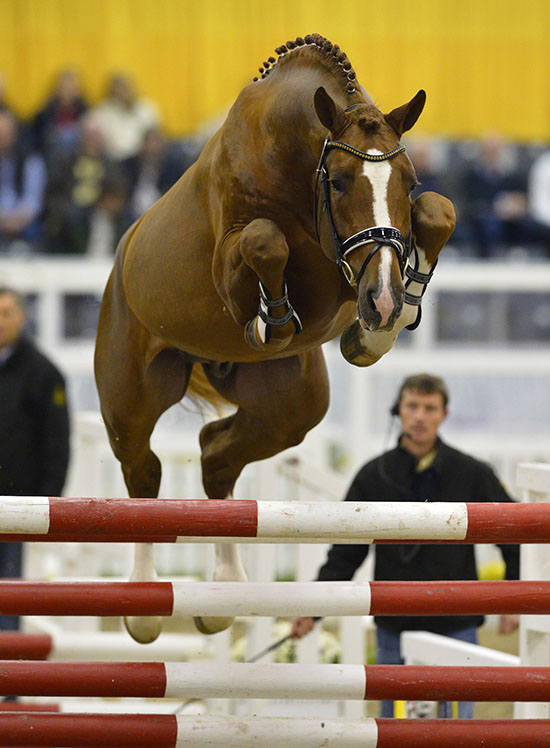


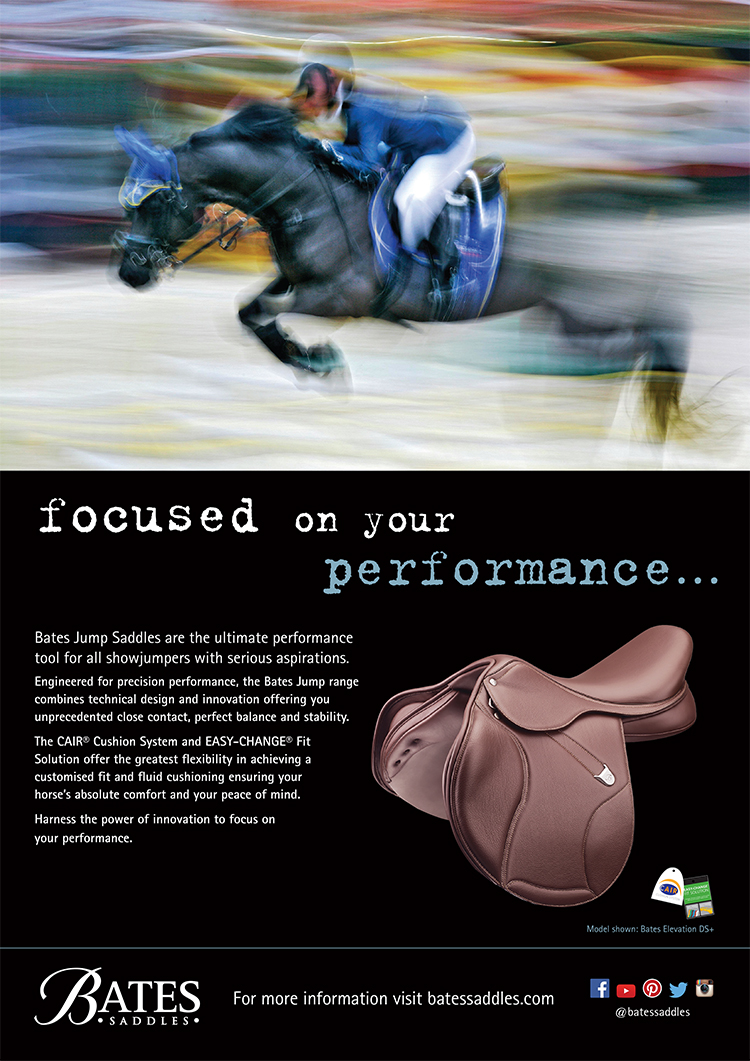

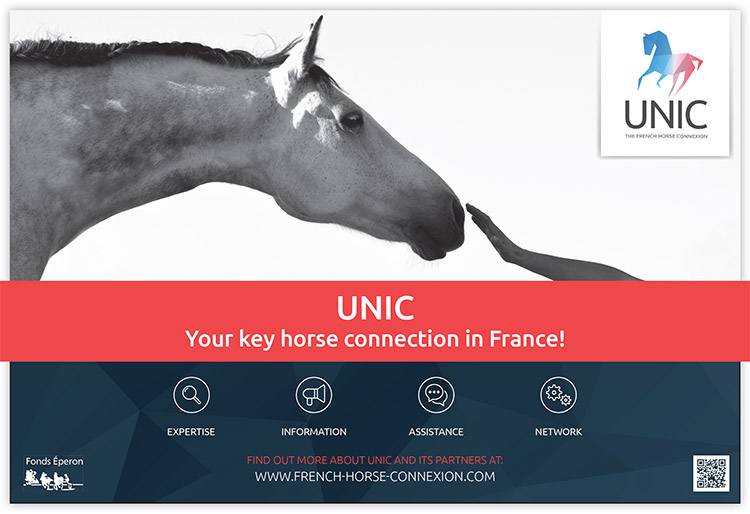
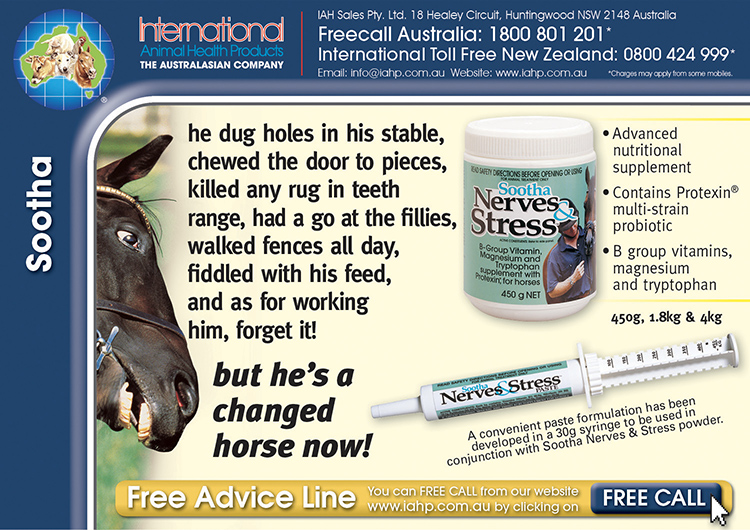
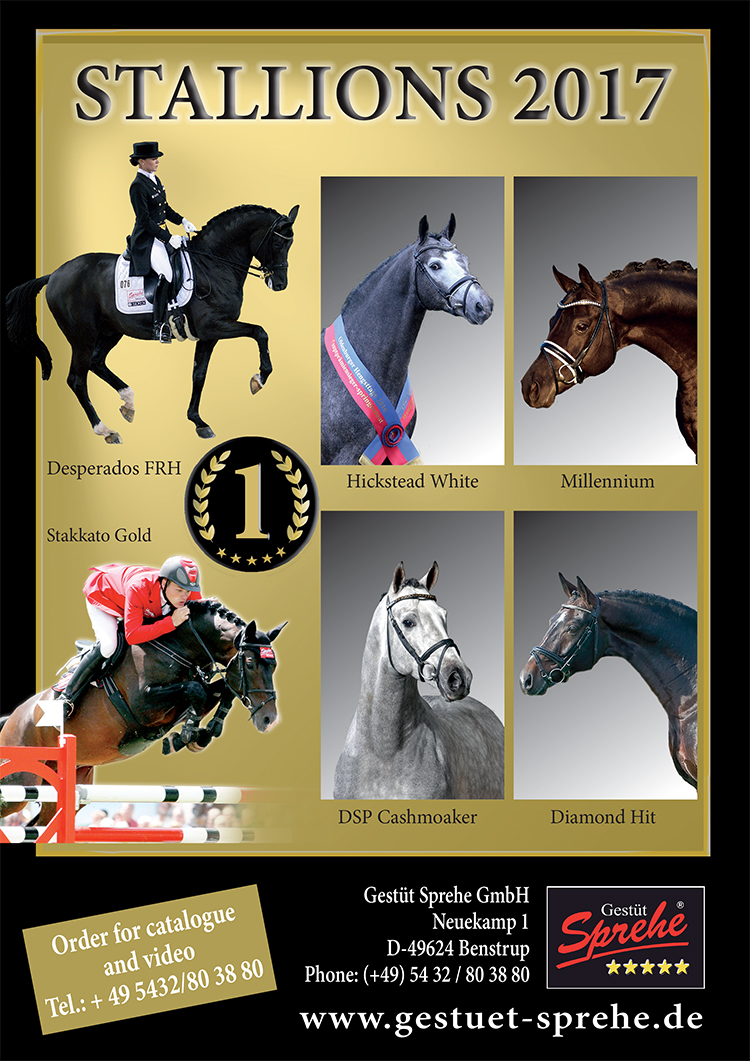

I don’t know when this article was published or re-issued, but I loved it. I rode at the same barn in NJ when the Leone brothers were starting to ride. I am a year older than Armand, and I have a picture of us in the Bergen (NJ) Record that was taken during one of our lessons. I had the great fortune to be able to ride with George at that same barn. I also had the great fortune to have a horse that I trained be selected for the USET and got to see him in the beautiful stables in Gladstone, ridden by Bert DeNemethy. Some of the greatest horseman ever were around during those years.